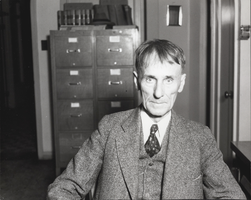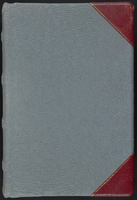Search the Special Collections and Archives Portal
Search Results

Photograph of Sims Ely, Boulder City, Nevada, 1931
Date
1931
Archival Collection
Description
The grayscale view of Sims Ely at his desk in an unknown building located in Boulder City, Nevada.
Image
"The New York City Office of the Comptroller Discussion Materials Regarding New York City OTB", 2007
Level of Description
File
Archival Collection
Eugene Martin Christiansen Papers
To request this item in person:
Collection Number: MS-00561
Collection Name: Eugene Martin Christiansen Papers
Box/Folder: Box 069
Collection Name: Eugene Martin Christiansen Papers
Box/Folder: Box 069
Archival Component
An Analysis of the Harry Allen Project; City of Boulder City, Nevada by Beck, R. W. & Associates, 1980 March
Level of Description
File
Archival Collection
Clark County Planning Commission Research Library Collection
To request this item in person:
Collection Number: MS-01027
Collection Name: Clark County Planning Commission Research Library Collection
Box/Folder: Box 83
Collection Name: Clark County Planning Commission Research Library Collection
Box/Folder: Box 83
Archival Component

March to Los Angeles: City Hall, Culinary Union, Los Angeles (Calif.), 1992 (folder 1 of 2), image 15
Date
1992
Description
Arrangement note: Series I. Demonstrations, Subseries I.B. Other Demonstrations and Strikes
Image

March to Los Angeles: City Hall, Culinary Union, Los Angeles (Calif.), 1992 (folder 2 of 2), image 15
Date
1992
Description
Arrangement note: Series I. Demonstrations, Subseries I.B. Other Demonstrations and Strikes
Image
Hangar built by the U.S. Navy at the Boulder City Airport, Boulder City, Nevada, approximately 1931-1935
Level of Description
File
Archival Collection
L. F. Manis Photograph Collection
To request this item in person:
Collection Number: PH-00100
Collection Name: L. F. Manis Photograph Collection
Box/Folder: Folder 22
Collection Name: L. F. Manis Photograph Collection
Box/Folder: Folder 22
Archival Component
"Virginia City-Queen of the Comstock" sign, Virginia City, Nevada: photographic slide, approximately 1950 to 1970
Level of Description
Item
Archival Collection
Robert B. Griffith Photograph Collection
To request this item in person:
Collection Number: PH-00106
Collection Name: Robert B. Griffith Photograph Collection
Box/Folder: Box 03
Collection Name: Robert B. Griffith Photograph Collection
Box/Folder: Box 03
Archival Component

Las Vegas City Commission Legal Documents, February 29, 1944 to February 21, 1945
Date
1944-02-29 to 1945-02-21
Archival Collection
Description
Bound volume of Las Vegas City Commission Legal Documents, February 29, 1944 to February 21, 1945
Text
Pagination
Refine my results
Content Type
Creator or Contributor
Subject
Archival Collection
Digital Project
Resource Type
Year
Material Type
Place
Language
Records Classification


